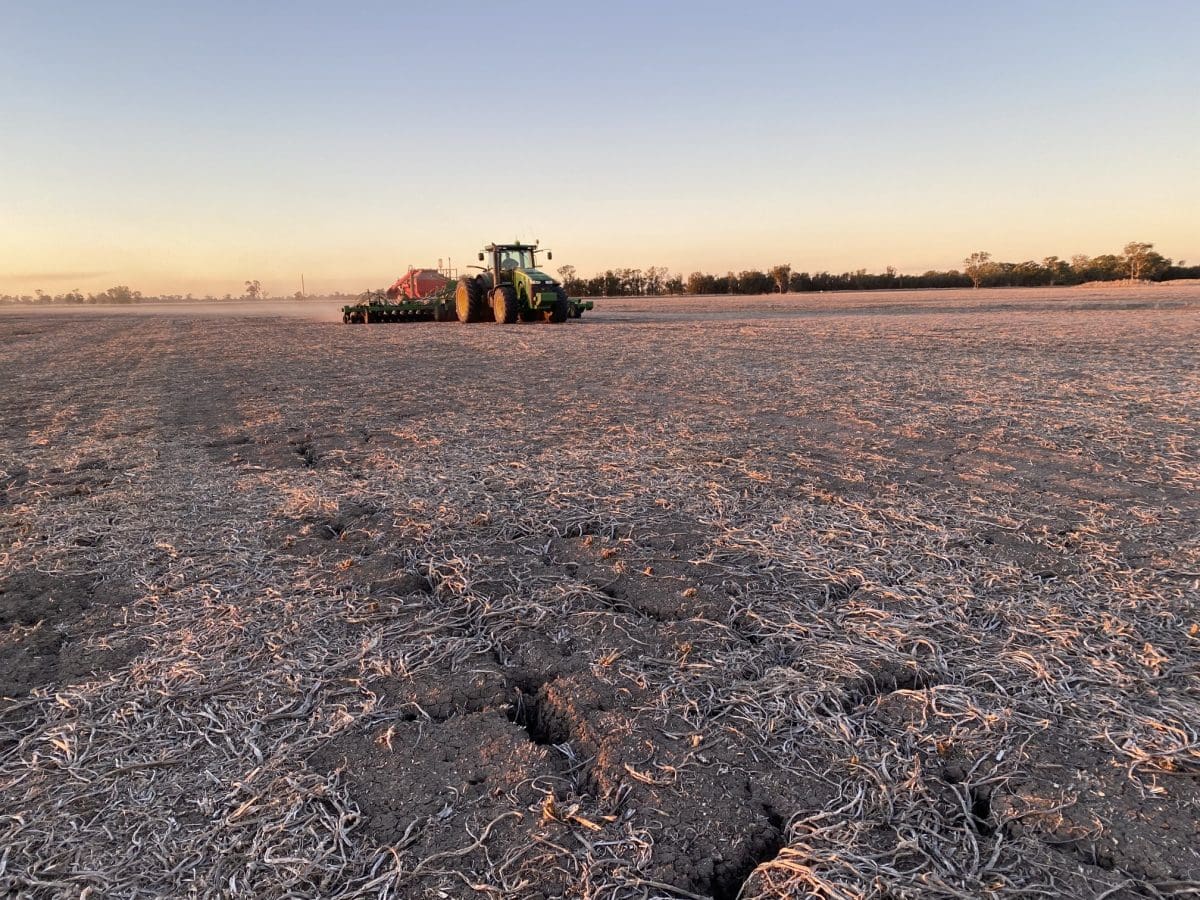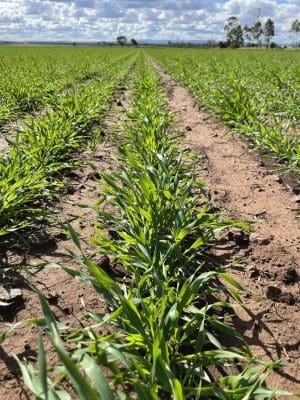
Dry sowing wheat in the Wimmera in Victoria ahead of 13mm of rain earlier this week. Photo: Bill Wallace
A SELL-OFF in US grain futures this week has pushed down new-crop values for Australian wheat and barley, but falls in nearby markets have been smaller as concerns mount about dry conditions in parts of Victoria and South Australia.
Winter cereals are up and away in ideal time in Western Australia, southern Queensland, most of New South Wales and southern areas of South Australia and Victoria.
This has seen the trade engage in some new-crop selling, but a dry-weather market is developing to reflect concerns about new-crop yield potential in SA’s Mid and Upper North and Murray-Mallee, and the Mallee and northern Wimmera in Victoria.
| Nearby | New-crop January | |
| Barley Downs | $300 steady | $278 down $2 |
| Wheat Downs | $332 steady | $310 down $5 |
| Sorghum Downs | $315 steady | $280 Mar-Apr down $5 |
| Barley Melbourne | $275 down $5 | $270 down $15 |
| Wheat Melbourne | $332 down $8 | $322 down $13 |
Table 1: Indicative delivered prices in Australian dollars per tonne.
Northern squeeze eases
Limited demand for nearby grain is matching limited selling interest from northern NSW and southern Queensland growers as they deal with the last of their summer-crop harvest and winter-crop planting.
“Feedlots are largely covered for July, and there’s more interest in booking August-September,” one trader said.

This barley crop at Bowenville on Queensland’s Darling Downs was planted in late April and is off to a flying start with a full subsoil moisture profile. Photo: Lance Wise
“The market always rallies in May-June when growers are planting their new crop, and we’ve seen it again this year.”
“If we’re seeing $300 now for May-June plus carry out to October for barley on the Downs, we’ll be looking for $15 downside before we enter the market.”
A freight squeeze has been supporting values since April, and traders said this looks set to ease now that current-crop exports are dropping to a more manageable pace.
This is allowing rail to carry more of the load into the ports of Newcastle and Brisbane, and is easing the demand for road freight.
“In the past six weeks I’ve been short on deliveries every week, but not this week,” a source in the feedlot sector said.
“If we don’t have that extra demand on B-doubles carting into port, and people paying $4-$5/t extra on road freight rather than demurrage because they’re loading their vessels late, prices can drop back a bit.”
Some northern growers are still planting wheat, barley and chickpeas.
“As the planting window starts to close, the offer has been more dominant than the bid side.”
Southern dry tempers sales
A long-awaited front brought rain to South Australia and Victoria on Monday and Tuesday, but registrations were disappointingly low in most places east of SA’s Spencer Gulf.
While a general rain in the next three weeks will keep average or better yield prospects in sight for winter crops, concerns are developing that the inland edge of south-eastern Australia’s grainbelt is in for a difficult year.
At Jamestown in SA’s Upper North, NR Ag agronomist Mark Smallacombe said high sheep prices and lambing were pushing some grain into the paddock.
“It’s getting a bit stressful for sheep, and with lambing going on, older sheep in particular need some extra feed if they’re not getting green pick,” Mr Smallacombe said.
“There is barley and oats going into feeders or being trailled out in the paddock, and legume screenings or legumes added to the brews as well as some hay.”
Pearsons Group trading manager Reagan Stroud said mixed farmers in north-west Victoria were starting to look for grain to help get their livestock through winter in good order.
“We’re getting more inquiry on grain from growers in the northern part of Victoria, whether it’s pulling it out of the system, or buying the odd load here and there.”
On average, most parts of the Mallee got 5-10 millimetres, while the Wimmera got up to 12-13mm, below the 15-20mm minimum needed to ensure even germination.
“It’s not as much as people had hoped for.”
In the prompt market, Mr Stroud said domestic consumers were looking to price July-September delivery.
“I’m not seeing a whole lot of people short like they were a month ago.”
“Feedlots seem to be looking for July-to-September barley, and growers aren’t giving it to them.”
Mr Stroud said domestic cash prices have fallen this month by much less than the US tumble would indicate.
“The US futures market has come off maybe $50/t in the past two-and-a-half weeks, and we have maybe come off $5.
“The impact for the domestic guy is how much gets exported around them.”
Trade sources have said the NSW crop is the buffer, and will be able to push grain across its borders if Victoria and/or South Australia have regional deficits.
“NSW is sitting pretty with the new crop.”
“Right now, we are competitive in a global sense, and if we continue to export at the pace we have been, supply will tighten.
“The Geelong and Melbourne markets are getting grain from southern NSW, and it’s those consumers in central Vic that get grain from the Mallee and the Wimmera that are finding it hard to buy.”
Logistics remains a factor in Victoria, with road supplying more than half the grain being shipped collectively out of Geelong and Melbourne, and rail doing the rest.
Grain Central: Get our free cropping news straight to your inbox – Click here
